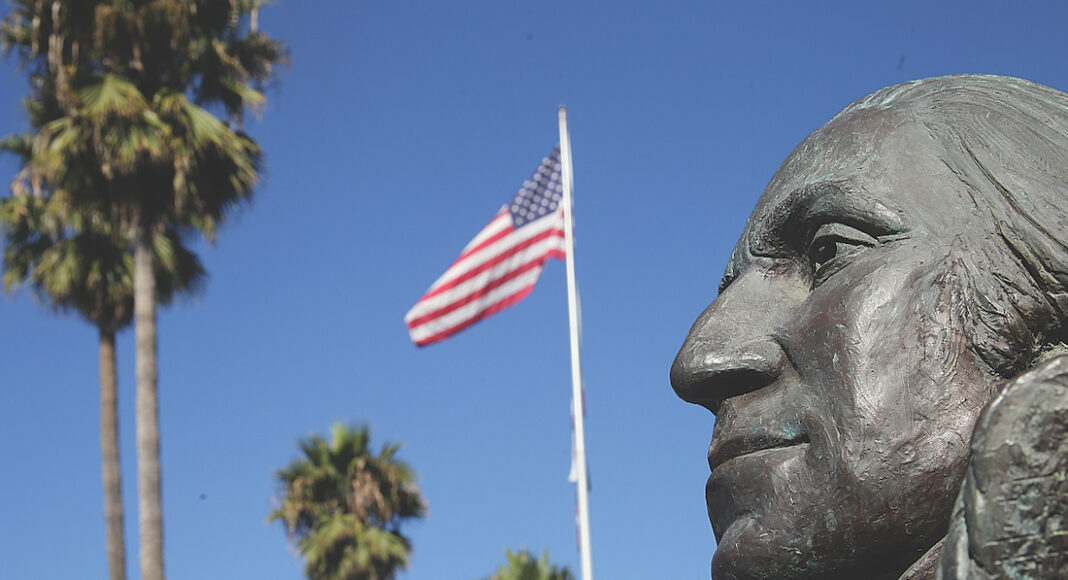The Watsonville Parks and Recreation Commission at its Monday virtual meeting recommended the City Council remove the George Washington bust from the City Plaza.
The recommendation, put forth by Commissioner Jessica Carrasco, deviates from that of Parks and Community Services staff, which proposed that the bust stay put, and that a “bilingual plaque that outlines a broad historical perspective” about the nation’s first president be added. Staff reached that recommendation from the feedback it received during a month-long community survey in which 60% of more than 1,200 respondents said they wanted it to remain in the historic park.
But a little less than two dozen community members who spoke during the meeting questioned whether the survey was a complete count of the community. The majority of the commission also did not believe the survey represented the community’s views on the bust, and instead sided with those in attendance.
“If we don’t listen to the people and the community, then what are we doing?” asked Commissioner Paul De Worken.
Commissioners Frank Barba and Abel Sanchez voted “no” on the recommendation. Wayne Hayashibara did not vote.
Carrasco said the bust should not be destroyed, but simply moved to another location and that the bilingual plaque be added.
It is unclear when the City Council will decide the statue’s fate. Parks and Community Services Director Nick Calubaquib said city staff would work with the incoming Mayor to schedule the item in early 2021.
Seventeen people spoke for the removal of the bust at Monday’s meeting, two were against its removal and three were indifferent.
Those in favor of its removal said the bust has turned into a symbol of white supremacy and racism since a cry of “white power” reportedly rang out during a rally organized by supporters of the statue in July. In addition, a photo of a person flashing an “OK” hand gesture, which the Anti-Defamation League has said can sometimes be associated with white supremacy, surfaced from that rally.
Support for keeping the bust, several attendees said, was a vote for white supremacy.
“Know that if you are siding with keeping the bust, that you’re siding with a race,” Ome Garcia said.
Commissioner Ana Hurtado-Aldaña said the city has not yet condemned the actions from the July rally, and called on local leaders to do so soon.
Commissioner De Worken was also critical of leadership, and accused the City Council of “hiding” from the issue and the conversation of race because of the election.
Commissioner Sanchez said that the removal of the bust would not end racism, and that he was concerned the issue has only sowed further division in the community. He said that support for keeping the statue did not equate to support for white supremacy.
“I really do wish that we could remove this statue and eradicate racism…but the fact is that its (removal is) not going to get rid of [racism],” he said.
Part of a $100,000 gift from the Alaga Family Estate as a dying wish of Lloyd F. Alaga, the bust has called the City Plaza home since 2001. The council unanimously approved the gift from Alaga in 1999, using $70,000 to create the bust and the rest to help restore the fountain in the park. Alaga also donated $200,000 to the Watsonville Public Library.
For nearly two decades it has sat mostly unnoticed at the park nestled into the center of the city, but debate around the bust began as several monuments to historic figures across the country were removed as a result of the Black Lives Matter movement.
At least three online petitions—both in favor of and against the bust—were circulated prompting city officials to bring the item to the commission for a “study session” in early August. The majority of the commission voiced its support for removing the bust, and called for the issue to be agendized by the City Council.
But the city instead circulated the online survey to gather more community input and held a town hall late last month to release the survey’s results.
People on both sides of the issue felt equally as strong about their stance, according to the survey results.
The majority of respondents who want the bust removed said it is a symbol of white supremacy and racism. They also said that it does not reflect the values of the community and that President Washington’s support of the genocide of indigenous people and ownership of slaves were also reasons for it to be removed.
Those who want to leave the statue in its place said in the survey that it honors President Washington’s actions that created and improved the country and that it is a reminder of the country’s history that should not be removed.
Geri Simmons at Monday’s meeting urged the commission to honor the results of the survey.
“The people have spoken,” she said.
But others picked apart the survey because it failed to gather key demographics of respondents such as age and race—two telltale signs of the changing times and beliefs, say those in favor of removal of the bust.
Several in attendance also said some community members did not feel comfortable filling out the survey because it required too much personal information such as a cell phone number and home address. The “digital divide” also tainted the results of the survey, those in favor of removal said.













